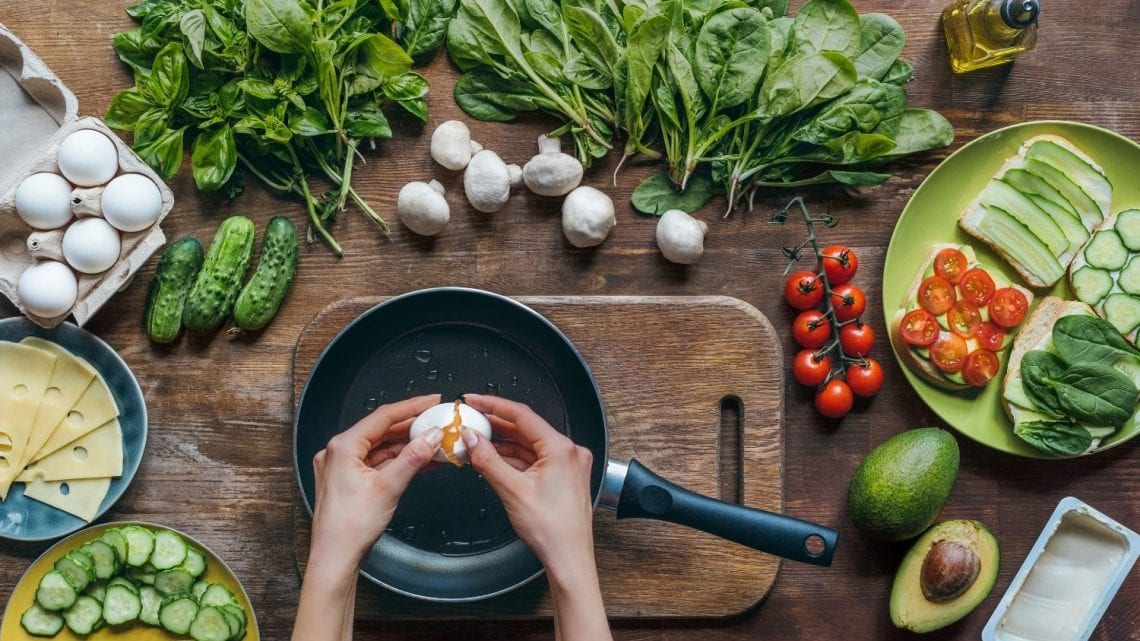
How to Feel Good About Cooking for One: Five Tips for Getting Started
Guest post by Kathryn Whittington, who loves cooking for one!
Perhaps you’ve been cooking for most of your life, but aren’t used to cooking for one. Perhaps you’re new to cooking and don’t really know where to start. Whatever your circumstances, getting used to feeding just yourself can be a challenge!
Here are my five top tips for getting started…
1. Don’t worry if you have leftovers
There are two big problems when catering for one. The first is that recipes are often written for 2 – 4 people. The second is that food is sold in packets or containers that are often too big for one person. It also works out more expensive to buy smaller portions. Shopping in individual shops like butchers or greengrocers can allow you to buy food in smaller quantities without the extra cost, but we don’t all have the opportunity or time to do that. You can also try dividing recipe quantities in half or even by 4 to reduce the amount you have left over. Even then, the savviest cook will sometimes end up with more food than they need! This doesn’t have to be a problem. If you end up with more food than you need for one meal, put it in a container, let it cool and store it in the fridge to eat later in the week. If you think it will be a while till you’ll want to eat it again, portion it out and save individual amounts in the freezer in Tupperware containers.

2, Do learn about portion sizes
We all grow up learning not to waste food. While leftovers aren’t a problem, habitually cooking too much food and then eating it all might be! There can be a particular issue if you don’t have anyone else holding you accountable for how much you eat. If you have no idea at all how much pasta or rice, or chicken, or pinto beans etc you should eat in one meal then there are a lot of portion size guides out there. Here’s one you can use to get started.
3. Develop a flexible store cupboard
There are some basic ingredients that can be used in a range of recipes. Generally, it’s helpful to have:
- cooking oil/fat
- salt
- pepper
- corn flour
- a few dried herbs and spices
- chopped tomatoes (canned)
- tomato puree
- stock cubes
- soy sauce and other flavourings or condiments (e.g.: Worcester sauce)
- dried pasta, rice, noodles
- sugar
- pulses and beans (either tinned or dried)
The exact make up of your store cupboard will depend on your personal taste so think about the food you like and stock up on ingredients you think will be useful. Having these foods to hand will allow you to cook a range of recipes without having to go to the shops for every meal.

4. Think and plan before you cook
What foods work best if you are going to be cooking for one person?
I love a roast, but cooking a whole leg of lamb for one person is going to leave you a lot of leftovers. That’s fine if you want the leftovers! If you don’t, then think about cooking a leg steak, or a loin instead. As above, you can also reduce recipe quantities e.g.: of curry, soup etc so you end up with fewer portions. However some types of dish just work better than others for solo cooking. Stir fries are easy to make for one person. Cooking a single fillet of fish with a sauce and some sides works well. Pasta with sauce, an omelette or a jacket potato also make good one person options when you are getting used to cooking for one.
5. Opt for quicker meals to begin with
In my experience, if you are learning to cook then it pays to start with options that don’t take a huge investment of time. That’s because you get the boost of accomplishment a little quicker. If you can show yourself that cooking for one doesn’t have to be complicated, then you are more likely to get into the habit of cooking regularly and well. Like everything, habit forming is about getting into a routine and doing something until it feels weird not to do it. Once you are comfortable with the routine, you can look at longer or more complex dishes.

Final thought
With some preparation and a few top tips, it’s possible to cook healthy meals that don’t take much time, and make good use of the leftovers. I hope you find this useful. Happy cooking!
Kathryn lives with her cat Bramble and a lot of house plants in Reading. She works in higher education and loves cooking, writing, and swimming.
If you enjoyed this article, you might also like 10 Deliciously Comforting Late Night Snacks That You Won’t Feel Guilty About and A Solo Guide to Effortless Entertaining
We send out a fortnightly newsletter – just leave your email address with us for the latest news, exclusive updates and offers from the Living Well Alone Project.





